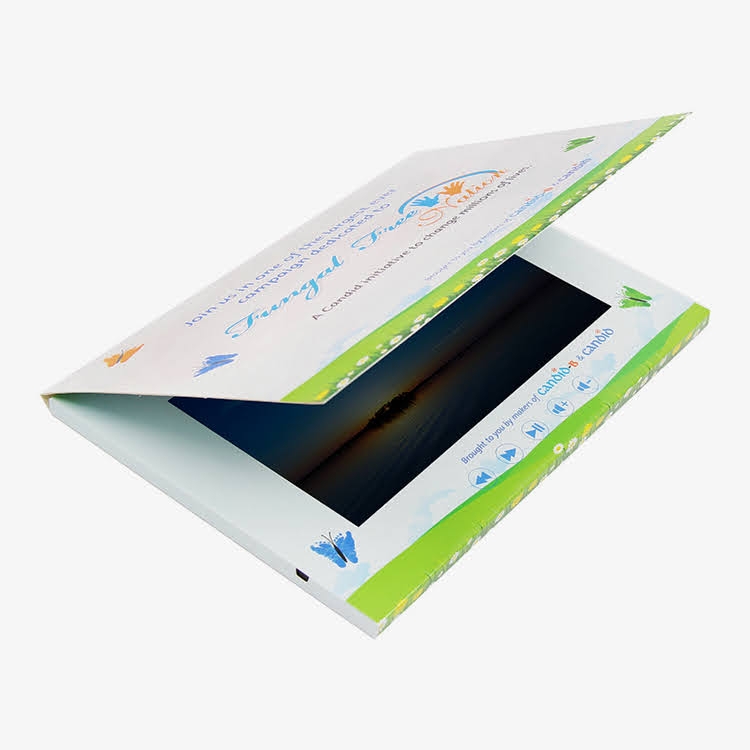Video brochures have carved out their own niche as part of physical marketing materials by combining the tactile appeal of print with the engagement of video content.
It took the traditional concept of a brochure and breathed new life into it by making it interactive, allowing you to serve content directly to the viewer. Providing you with more options for displaying your messaging, you’re no longer limited by the physical constraints of the page, as you’re loading information onto a memory desk.
Videos can be as long as the memory disk allows, but this does have a cost and physical constraint. The longer the video, the higher the quality of the video or the amount of videos you wish to add has a limit.
As marketers reached those limits and continue to push for more, the next evolution takes this concept further by integrating WiFi connectivity, allowing these devices to stream content directly from cloud servers and offer interactive experiences that traditional video brochures simply cannot match.
Understanding WiFi-Enabled Video Brochures
A WiFi-enabled video brochure is essentially a portable marketing device that combines a small LCD screen, basic computing power, WiFi connectivity, and battery management within a traditional brochure format.
Unlike standard video brochures that rely on pre-loaded content stored on internal memory, these connected devices can access fresh content from your cloud infrastructure, update themselves automatically, and provide interactive experiences that respond to user input.
The core advantage lies in the dynamic nature of the content.
Rather than being limited to a fixed video that was loaded during manufacturing, these devices can pull real-time content, showcase different products based on user preferences, or even provide personalized experiences based on the time of day or location.
Essential Hardware Components
Building a WiFi-enabled video brochure requires careful selection of components that balance functionality, power consumption, and form factor. The foundation starts with a low-power microcontroller or single-board computer capable of WiFi communication.
Options like the ESP32 series offer excellent WiFi capabilities while maintaining low power consumption, making them ideal for battery-operated devices.
Visual
The display component typically involves a small LCD screen ranging from 2.4 to 7 inches, depending on your design requirements. IPS displays provide better viewing angles and color reproduction, which is crucial for marketing materials.
The screen should support video playback at reasonable resolutions while not draining the battery excessively.
Audio
Audio capabilities require a small speaker system and audio amplifier circuit. Since these devices are meant to be portable and used in various environments, the audio system should be designed to provide clear sound without being overly power-hungry.
Battery
Battery management is critical for user experience. Lithium polymer batteries offer good energy density and can be shaped to fit the brochure form factor. The system should include proper charging circuits, preferably with USB-C connectivity for modern compatibility, and power management that can put the device into sleep mode when not in use.
Added components
Additional components include tactile buttons for user interaction, status LEDs to indicate connectivity and charging states, and potentially sensors like accelerometers to detect when the brochure is opened or closed.
Software Architecture and Connectivity
The software stack for a WiFi-enabled video brochure operates on multiple layers. At the base level, you need an embedded operating system or firmware that can handle WiFi connectivity, media playback, and user interface management.
For more complex applications, lightweight Linux distributions designed for embedded systems work well, while simpler implementations might use real-time operating systems or even bare-metal programming.
WiFi connectivity management is crucial since these devices will often operate in environments with various network configurations.
The system should support multiple connection methods, including WPA2/WPA3 networks, captive portals, and potentially mobile hotspot connections. A robust connection manager should handle network switching, reconnection after signal loss, and graceful degradation when connectivity is poor.
The media playback system needs to support streaming protocols and handle buffering intelligently. Since users expect immediate responsiveness, the system should pre-cache content when possible while maintaining the ability to stream fresh content when needed.
Video codecs should be optimized for the available processing power and display resolution.
User interface management involves creating intuitive touch or button-based navigation systems. The interface should provide clear feedback about connectivity status, loading states, and available content options. Since these are marketing materials, the interface design should align with brand guidelines and provide a premium user experience.
Cloud Infrastructure and Content Management
The cloud infrastructure supporting WiFi-enabled video brochures requires careful planning to ensure reliable content delivery and scalability.
A content delivery network (CDN) forms the backbone of the system, ensuring that video content loads quickly regardless of the user’s geographic location. Services like Amazon CloudFront, Cloudflare, and Google Cloud CDN employ a multi-cloud model across a range of service providers with the global distribution needed for consistent performance.
Content management systems should be designed with marketing teams in mind, providing easy-to-use interfaces for uploading videos, creating interactive demos, and scheduling content updates. The system should support various content types, including videos, images, interactive presentations, and even simple web applications that can run within the brochure’s browser-like environment.
Analytics and tracking capabilities provide valuable insights into how recipients interact with the brochures. The system should track metrics like content viewing duration, interaction patterns, and user preferences while respecting privacy regulations.
This data helps optimize content and measure the effectiveness of marketing campaigns.
The backend should also handle device management, including firmware updates, content synchronization, and device status monitoring. Remote management capabilities allow marketing teams to update content across all deployed brochures simultaneously or target specific devices based on criteria like location or recipient demographics.
Interactive Features and User Experience
Interactive features distinguish WiFi-enabled video brochures from traditional marketing materials. Product configurators allow users to customize products in real-time, seeing how different options affect appearance, pricing, or specifications. This interactivity creates engagement that static materials cannot achieve.
Virtual demonstrations can guide users through complex products or services step-by-step.
Rather than watching a generic product video, users can choose their specific use case and receive tailored content that addresses their particular needs and concerns.
Lead capture capabilities built into the brochures can collect contact information, preferences, or feedback directly from interested users. This data can be transmitted back to your CRM systems in real-time, enabling immediate follow-up from sales teams.
Integration with augmented reality features, while technically challenging in a small form factor, can provide unique experiences where users point the device at physical objects to receive additional information or overlaid digital content.
Technical Implementation Challenges
Power management presents ongoing challenges in WiFi-enabled devices. Video playback and WiFi communication are power-intensive operations, and users expect devices to work for extended periods without charging.
Implementing intelligent power management that dims screens during inactivity, manages WiFi connections efficiently, and optimizes processing loads is essential for practical deployment.
Network reliability varies significantly across different environments. The system must gracefully handle weak signals, network outages, and varying bandwidth conditions. Implementing progressive download strategies, offline content caching, and user-friendly error messages helps maintain a positive experience even when connectivity is poor.
Security considerations are paramount when devices connect to various networks and handle potentially sensitive marketing data.
Implementing proper encryption for data transmission, secure storage for any cached content, and protection against common IoT vulnerabilities is essential for maintaining user trust and corporate security standards.
Thermal management in compact form factors requires careful component selection and potentially active cooling solutions. Video processing and WiFi communication generate heat that must be dissipated without making the device uncomfortable to hold or damaging internal components.
Content Strategy and Deployment
Successful WiFi-enabled video brochure campaigns require strategic content planning. Content should be designed specifically for the small screen format and expected viewing conditions. Videos should have clear audio, high contrast visuals, and concise messaging that can be understood even in noisy environments.
Interactive content should be intuitive enough that users can navigate without instruction. Touch targets should be appropriately sized for finger navigation, and the interface should provide clear visual feedback for all interactions.
Content scheduling allows for dynamic campaigns where different content is presented based on time, location, or user behavior. A product launch campaign might show teaser content initially, detailed specifications closer to launch, and availability information once products are ready for purchase.
Personalization capabilities can tailor content based on known information about recipients. Integration with CRM systems allows brochures to display content relevant to the recipient’s industry, company size, or previous interactions with your brand.
Manufacturing and Quality Considerations
Manufacturing WiFi-enabled video brochures requires partnerships with electronics manufacturers experienced in small-batch custom devices. The integration of electronic components with traditional printing processes demands careful coordination between electronics assembly and final packaging.
Quality
Quality assurance testing must cover both electronic functionality and physical durability. Devices should withstand normal handling, shipping conditions, and various environmental factors while maintaining reliable WiFi connectivity and media playback capabilities.
Cost
Cost considerations include both initial manufacturing costs and ongoing operational expenses for cloud infrastructure and connectivity. Pricing models should account for the enhanced engagement and lead generation capabilities these devices provide compared to traditional marketing materials.
Measuring Success and ROI
The connected nature of WiFi-enabled video brochures provides unprecedented insights into marketing material effectiveness. Detailed analytics show exactly how recipients interact with content, which sections generate the most interest, and how engagement correlates with subsequent purchasing behavior.
Conversion tracking can follow users from initial brochure interaction through website visits, lead form submissions, and eventual sales. This end-to-end tracking provides clear ROI measurements that justify the increased investment in connected marketing materials.
A/B testing capabilities allow for real-time optimization of content and user experience. Different versions of content can be served to different devices, with performance metrics guiding decisions about which approaches work best for specific audiences or use cases.
Future Developments and Considerations
The evolution of WiFi-enabled video brochures continues with emerging technologies. 5G connectivity promises faster content loading and the ability to stream higher-quality content. Edge computing capabilities could enable more sophisticated interactive features and real-time personalization.
Integration with emerging technologies like voice assistants, advanced gesture recognition, or even simple AI-powered chatbots could further differentiate these marketing tools from traditional materials.
Sustainability considerations are becoming increasingly important in marketing material decisions.
Designing devices for longevity, repairability, and eventual recycling helps address environmental concerns while potentially reducing long-term costs.
WiFi-enabled video brochures represent a significant advancement in marketing technology, combining the physical presence of traditional materials with the dynamic capabilities of digital platforms. Success requires careful attention to hardware design, software implementation, cloud infrastructure, and content strategy.
When executed well, these devices provide measurable improvements in engagement, lead generation, and marketing ROI while offering recipients genuinely useful and memorable experiences.
Ready to order your video brochures?
Curveball Media’s custom video brochures are designed to help you connect with clients, showcase your cases, and grow your firm’s brand. Contact us today to learn how we can help you take your legal services marketing strategy to new heights and bring your vision to life!
For more creative marketing ideas, check out our blog and start crafting campaigns that truly connect. Contact us now for more information.


